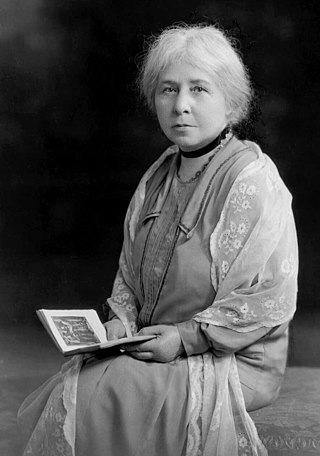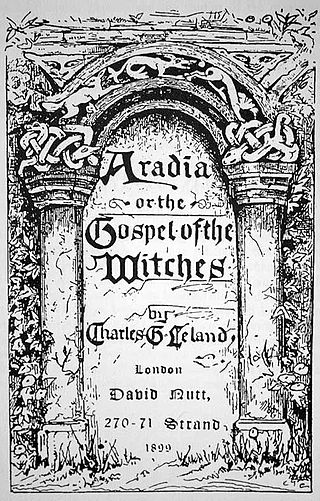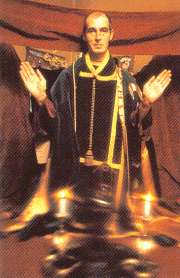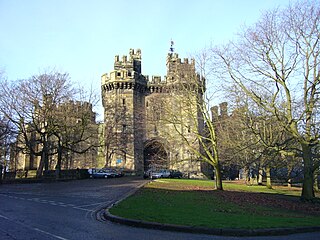Related Research Articles

Margaret Alice Murray was a British-Indian Egyptologist, archaeologist, anthropologist, historian, and folklorist who was born in India. The first woman to be appointed as a lecturer in archaeology in the United Kingdom, she worked at University College London (UCL) from 1898 to 1935. She served as president of the Folklore Society from 1953 to 1955, and published widely over the course of her career.

Wicca, also known as "The Craft", or the "Craft of the Wise" is a modern pagan, syncretic, earth centered religion. Scholars of religion categorize it as both a new religious movement and as part of occultist Western esotericism. It was developed in England during the first half of the 20th century and was introduced to the public in 1954 by Gerald Gardner, a retired British civil servant. Wicca draws upon a diverse set of ancient pagan and 20th-century hermetic motifs for its theological structure and ritual practices.
Aradia is one of the principal figures in the American folklorist Charles Godfrey Leland's 1899 work Aradia, or the Gospel of the Witches, which he believed to be a genuine religious text used by a group of pagan witches in Tuscany, a claim that has subsequently been disputed by other folklorists and historians. In Leland's Gospel, Aradia is portrayed as a messiah who was sent to Earth in order to teach the oppressed peasants how to perform witchcraft to use against the Roman Catholic Church and the upper classes.

The North Berwick witch trials were the trials in 1590 of a number of people from East Lothian, Scotland, accused of witchcraft in the St Andrew's Auld Kirk in North Berwick on Halloween night. They ran for two years, and implicated over 70 people. These included Francis Stewart, 5th Earl of Bothwell, on charges of high treason.
Frank Stewart Farrar was an English screenwriter, novelist and prominent figure in the Neopagan religion of Wicca, which he devoted much of his later life to propagating with the aid of his seventh wife, Janet Farrar, and then his friend Gavin Bone as well. A devout communist in early life, he worked as a reporter for such newspapers as the Soviet Weekly and the Daily Worker, and also served in the British army during the Second World War. He was responsible for writing episodes for such television series as Dr. Finlay's Casebook, Armchair Theatre and Crossroads, and for his work in writing radio scripts won a Writer's Guild Award. He also published a string of novels, written in such disparate genres as crime, romance and fantasy.

Aradia, or the Gospel of the Witches is a book composed by the American folklorist Charles Godfrey Leland that was published in 1899. It contains what he believed was the religious text of a group of pagan witches in Tuscany, Italy that documented their beliefs and rituals, although various historians and folklorists have disputed the existence of such a group. In the 20th century, the book was very influential in the development of the contemporary Pagan religion of Wicca.

Janet Farrar is a British teacher and author of books on Wicca and Neopaganism. Along with her two husbands, Stewart Farrar and Gavin Bone, she has published "some of the most influential books on modern Witchcraft to date". According to George Knowles, "some seventy five percent of Wiccans both in the Republic and Northern Ireland can trace their roots back to the Farrars."

Alex Sanders, born Orrell Alexander Carter, who went under the craft name Verbius, was an English occultist and High Priest in the modern Pagan religion of Wicca, responsible for founding, and later developing with Maxine Sanders, the tradition of Alexandrian Wicca, also called Alexandrian Witchcraft, during the 1960s.
Maxine Sanders is a key figure in the development of modern pagan witchcraft and Wicca and, along with her late husband, Alex Sanders, the co-founder of Alexandrian Wicca.
The history of Wicca documents the rise of the Neopagan religion of Wicca and related witchcraft-based Neopagan religions. Wicca originated in the early 20th century, when it developed amongst secretive covens in England who were basing their religious beliefs and practices upon what they read of the historical witch-cult in the works of such writers as Margaret Murray. It also is based on the beliefs from the magic that Gerald Gardner saw when he was in India. It was subsequently founded in the 1950s by Gardner, who claimed to have been initiated into the Craft – as Wicca is often known – by the New Forest coven in 1939. Gardner's form of Wicca, the Gardnerian tradition, was spread by both him and his followers like the High Priestesses Doreen Valiente, Patricia Crowther and Eleanor Bone into other parts of the British Isles, and also into other, predominantly English-speaking, countries across the world. In the 1960s, new figures arose in Britain who popularized their own forms of the religion, including Robert Cochrane, Sybil Leek and Alex Sanders, and organizations began to be formed to propagate it, such as the Witchcraft Research Association. It was during this decade that the faith was transported to the United States, where it was further adapted into new traditions such as Feri, 1734 and Dianic Wicca in the ensuing decades, and where organizations such as the Covenant of the Goddess were formed.
The Tempe Union High School District is a school district of high schools in Tempe, Arizona, USA. Its service area includes all of Tempe, the city of Chandler, Arizona west of the Loop 101, Guadalupe, the Gila River Indian Community in Maricopa County, and the Ahwatukee area of Phoenix.

The trials of the Pendle witches in 1612 are among the most famous witch trials in English history, and some of the best recorded of the 17th century. The twelve accused lived in the area surrounding Pendle Hill in Lancashire, and were charged with the murders of ten people by the use of witchcraft. All but two were tried at Lancaster Assizes on 18–19 August 1612, along with the Samlesbury witches and others, in a series of trials that have become known as the Lancashire witch trials. One was tried at York Assizes on 27 July 1612, and another died in prison. Of the eleven who went to trial – nine women and two men – ten were found guilty and executed by hanging; one was found not guilty.

The witch-cult hypothesis is a discredited theory that the witch trials of the Early Modern period were an attempt to suppress a pagan religion that had survived the Christianization of Europe. According to its proponents, accused witches were actually followers of this alleged religion. They argue that the supposed 'witch cult' revolved around worshiping a Horned God of fertility and the underworld, whose Christian persecutors identified with the Devil, and whose followers held nocturnal rites at the witches' Sabbath.

The Samlesbury witches were three women from the Lancashire village of Samlesbury – Jane Southworth, Jennet Bierley, and Ellen Bierley – accused by a 14-year-old girl, Grace Sowerbutts, of practising witchcraft. Their trial at Lancaster Assizes in England on 19 August 1612 was one in a series of witch trials held there over two days, among the most infamous in English history. The trials were unusual for England at that time in two respects: Thomas Potts, the clerk to the court, published the proceedings in his The Wonderfull Discoverie of Witches in the Countie of Lancaster; and the number of the accused found guilty and hanged was unusually high, ten at Lancaster and another at York. All three of the Samlesbury women were acquitted.
The Arizona State Schools for the Deaf and the Blind(ASDB) is an Arizona state agency, with its administrative headquarters in Tucson. It operates three schools for the deaf and blind, and five regional cooperatives throughout the state:

Witchcraft in Orkney possibly has its roots in the settlement of Norsemen on the archipelago from the eighth century onwards. Until the early modern period magical powers were accepted as part of the general lifestyle, but witch-hunts began on the mainland of Scotland in about 1550, and the Scottish Witchcraft Act of 1563 made witchcraft or consultation with witches a crime punishable by death. One of the first Orcadians tried and executed for witchcraft was Allison Balfour, in 1594. Balfour, her elderly husband and two young children, were subjected to severe torture for two days to elicit a confession from her.

Elspeth Reoch was an alleged Scottish witch. She was born in Caithness but as a child spent time with relatives on an island in Lochaber prior to travelling to the mainland of Orkney.

Margaret Aitken, known as the Great Witch of Balwearie, was an important figure in the great Scottish witchcraft panic of 1597 as her actions effectively led to an end of that series of witch trials. After being accused of witchcraft Aitken confessed but then identified hundreds of women as other witches to save her own life. She was exposed as a fraud a few months later and was burnt at the stake.

The Maryland Witch Trials were a series of hearings and prosecutions of people accused of witchcraft in Colonial Maryland between June 1654, and October 1712. It was not unique, but is a Colonial American example of the much broader phenomenon of witch trials in the early modern period, which took place also in Europe.
Katherine Campbell was a maidservant accused of theft and witchcraft during the last major witch hunt in Scotland, the Paisley witch trials.
References
- 1 2 3 4 5 6 Cohen, Jerry (March 31, 1971). "'Teacher-Witch' Loses Her Job". The Tuscaloosa News. Tuscaloosa, Alabama. p. 12.
- 1 2 3 4 5 6 7 Liddick, Betty (February 15, 1972). "'Witch' Tag Clings to Fired Teacher". The Tuscaloosa News. Tuscaloosa, Alabama. p. 14.
- ↑ "Teacher Fired in Witch Case". The Milwaukee Journal. Milwaukee, Wisconsin. March 19, 1971. p. 14.[ permanent dead link ]
- 1 2 3 4 Strong, Cherlyn Gardner (January 16, 2010). "Revisiting the Flowing Wells "Witch Trial" of 1971". Tucson Citizen.com. Archived from the original on September 19, 2013. Retrieved September 19, 2013.
- ↑ "Arizona Teacher Faces Witch Charge". The Pittsburgh Press. Pittsburgh, Pennsylvania. December 2, 1970. p. 6 sec. 2.
- ↑ "Teacher Lost to Classes for a Spell". The Blade. Toledo, Ohio. December 11, 1970. p. 12.
- ↑ "Teacher Alleged to Claim She is a Witch Suspended". St. Joseph News-Press. St. Joseph, Missouri. December 2, 1970. p. 1C.
- 1 2 "Tucson hearing set for 'Witch'". The Prescott Courier. Prescott, Arizona. March 18, 1971. p. 1.
- ↑ "Teacher Appeals Board Charge of Witchcraft". The Bryan Times. Bryan, Ohio. December 3, 1970. p. 5.
- ↑ "Witch Teacher". Lodi News-Sentinel. Lodi, California. March 19, 1971. p. 1.
- ↑ "'Witch' Gets Job Back in School Board Case". Sarasota Herald-Tribune. Sarasota, Florida. December 7, 1971. p. 6B.
- ↑ Spencer, Monica (January 26, 2017). "Most People Don't Know A Witch Trial Took Place Right Here In Arizona". OnlyInYourState.